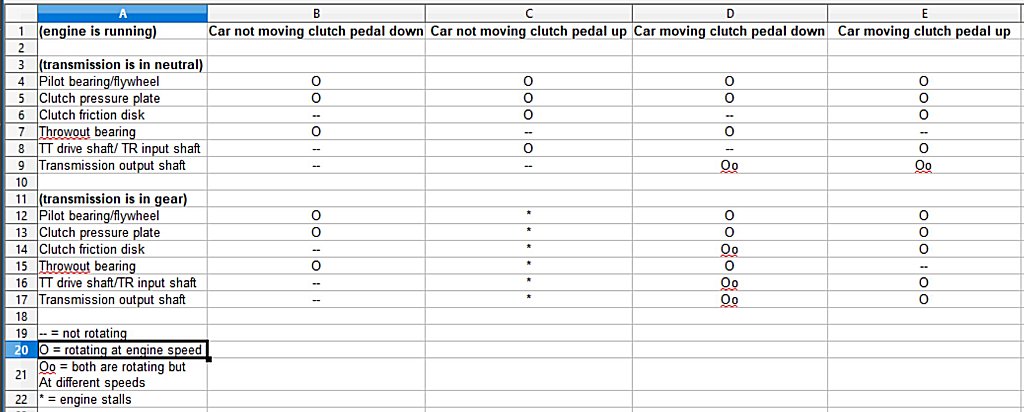I'm still trying to get my mind straight about what potentially could be causing this drivetrain noise I'm having, so I decided to set up a chart that would show me what parts are rotating and which ones are not under particular circumstances.

The idea being that likely the noise I am hearing is coming from a part that is rotating pressed against a part that is not rotating. Or in a transition stage from a rotating part pressed against a non-rotating part to make the non-rotating part rotate.
In my case, the noise is most prevalent, although intermittent, when the car begins to move from a dead stop with me lifting up on the clutch pedal which brings the clutch pressure plate in contact with the clutch disk and presses it against the flywheel. A complication here is that it seems that the drivetrain has to actually be under load for that noise to appear. Working the clutch while the transmission is out of gear never seems to make the noise appear, whether the car is moving or not. In the video I did earlier, just the load of applying force to the rear wheels seemed sufficient to make the noise evident. Sometimes.
So there appears to be several components that are mechanically tied together and act as one concerning their rotation.
They are:
- Pilot bearing, flywheel, and clutch pressure plate.
- Clutch disk, torque tube input shaft, torque tube driveshaft, torque tube output shaft, and transmission input shaft
- Throwout bearing
- Transmission output shaft, differential, rear wheels
#1 is tied to engine speed. If the engine is running, those parts are rotating.
#2 is tied together as a single unit, effectively. If one part is rotating, they are all rotating.
#3 is only rotating when the clutch pedal is down, pressing it against the fingers of the rotating clutch pressure plate.
#4 is only rotating if the car is actually in motion, as they are tied to the rear wheels. So if the car is moving, they are all moving.
So the three conditions to be considered with all these moving parts are:
- Is the car moving or stationary?
- Is the transmission in gear or not in gear?
- Is the clutch pedal up or down?
So when I am hearing the drivetrain noise, the car is stationary, the transmission is in gear, and I am in the process of lifting up on the clutch pedal to bring the clutch pressure plate against the clutch disk, which begins to impart rotational energy through the torque tube input shaft, through the driveshaft to the torque tube output shaft, into the transmission input shaft, through the transmission output shaft to the differential, and then to the rear wheels.
Until I begin to release pressure on the clutch pedal to engage the clutch pressure plate against the clutch disk, there is no noticeable noise anywhere that I have noticed. When the car is sitting still in idle with the clutch pressed down, transmission in gear or out of gear, there is no noise. When the clutch pedal is fully released in the up position with the transmission out of gear and the car not moving, there is no noise. When the car is moving with the clutch pedal up or down, transmission in gear or out, there is no noise.
The ONLY time there is drivetrain noise is when the clutch pedal is in transition from being fully down to fully up with the transmission in gear. And sometimes I can hear a faint squeal and feel a shudder in the shifter during gear shifts. Again, highly intermittent, and only in the process of the clutch pedal being lifted after the gear shift change.
Today I took the car out to test an idea I had. What I wanted to do was to run the car up to speed, and then leaving the transmission in gear, let off the gas pedal to bring the engine speed down to idle, then push in the clutch pedal to disengage the clutch pressure plate from the clutch disk. Therefore the car's speed would actually be high, but the engine speed would be at idle. That would have the drive train from the clutch disk back to the rear wheels spinning rapidly, yet the pilot bearing, flywheel, and clutch pressure plate would be only at idle speed. The idea was that if the pilot bearing were bad, then in this condition, with the torque tube input shaft spinning rapidly, if the pilot bearing were shot, I would hear a clatter or squealing as the nose of the input shaft rattled around in the bad pilot bearing. However, no such noise was evident when I tried that. I tried it a couple of times, just to be sure. So much for that idea.
Of course, the drivetrain noise didn't show up the entire time I was driving the car, so I'm not sure I really proved anything. But I would think with a positive solid failure of any of the above listed components, the noise would be constant, and easily reproduced on demand.
So what does this all mean? What it likely means is that when I have someone else look at this, that drivetrain noise will not be able to be reproduced, and whoever is looking at it for me will think I'm some kind of nut with an imagined problem.
